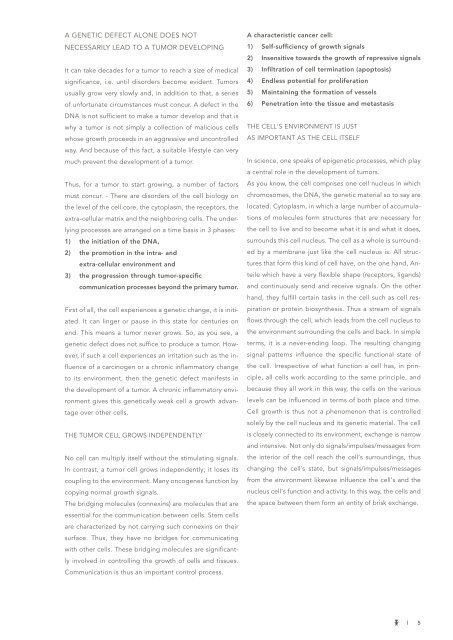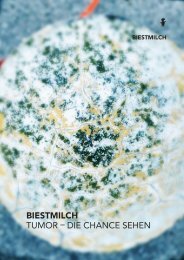Tumor – see the opportunity
Susann Kraeftner, MD – If you would like to pluck up the courage to make your own decisions; if you don‘t want to let the opinions of others make you doubtful, those presented to you in the outside world and inside clinics and health care centers, inside the territories of science where one believes to have entered the realm of truth, if you have realized for yourself that the only right way is the way you have chosen for yourself, then give in to reading the next pages. If you have questions feel free to ask www.biestmilch.com/helpdesk
Susann Kraeftner, MD – If you would like to pluck up the courage to make your own decisions; if you don‘t want to let the opinions of others make you doubtful, those presented to you in the outside world and inside clinics and health care centers, inside the territories of science where one believes to have entered the realm of truth, if you have realized for yourself that the only right way is the way you have chosen for yourself, then give in to reading the next pages. If you have questions feel free to ask www.biestmilch.com/helpdesk
Create successful ePaper yourself
Turn your PDF publications into a flip-book with our unique Google optimized e-Paper software.
A GENETIC DEFECT ALONE DOES NOT<br />
NECESSARILY LEAD TO A TUMOR DEVELOPING<br />
It can take decades for a tumor to reach a size of medical<br />
significance, i.e. until disorders become evident. <strong>Tumor</strong>s<br />
usually grow very slowly and, in addition to that, a series<br />
of unfortunate circumstances must concur. A defect in <strong>the</strong><br />
DNA is not sufficient to make a tumor develop and that is<br />
why a tumor is not simply a collection of malicious cells<br />
whose growth proceeds in an aggressive and uncontrolled<br />
way. And because of this fact, a suitable lifestyle can very<br />
much prevent <strong>the</strong> development of a tumor.<br />
Thus, for a tumor to start growing, a number of factors<br />
must concur. - There are disorders of <strong>the</strong> cell biology on<br />
<strong>the</strong> level of <strong>the</strong> cell core, <strong>the</strong> cytoplasm, <strong>the</strong> receptors, <strong>the</strong><br />
extra-cellular matrix and <strong>the</strong> neighboring cells. The underlying<br />
processes are arranged on a time basis in 3 phases:<br />
1) <strong>the</strong> initiation of <strong>the</strong> DNA,<br />
2) <strong>the</strong> promotion in <strong>the</strong> intra- and<br />
extra-cellular environment and<br />
3) <strong>the</strong> progression through tumor-specific<br />
communication processes beyond <strong>the</strong> primary tumor.<br />
First of all, <strong>the</strong> cell experiences a genetic change, it is initiated.<br />
It can linger or pause in this state for centuries on<br />
end. This means a tumor never grows. So, as you <strong>see</strong>, a<br />
genetic defect does not suffice to produce a tumor. However,<br />
if such a cell experiences an irritation such as <strong>the</strong> influence<br />
of a carcinogen or a chronic inflammatory change<br />
to its environment, <strong>the</strong>n <strong>the</strong> genetic defect manifests in<br />
<strong>the</strong> development of a tumor. A chronic inflammatory environment<br />
gives this genetically weak cell a growth advantage<br />
over o<strong>the</strong>r cells.<br />
THE TUMOR CELL GROWS INDEPENDENTLY<br />
No cell can multiply itself without <strong>the</strong> stimulating signals.<br />
In contrast, a tumor cell grows independently; it loses its<br />
coupling to <strong>the</strong> environment. Many oncogenes function by<br />
copying normal growth signals.<br />
The bridging molecules (connexins) are molecules that are<br />
essential for <strong>the</strong> communication between cells. Stem cells<br />
are characterized by not carrying such connexins on <strong>the</strong>ir<br />
surface. Thus, <strong>the</strong>y have no bridges for communicating<br />
with o<strong>the</strong>r cells. These bridging molecules are significantly<br />
involved in controlling <strong>the</strong> growth of cells and tissues.<br />
Communication is thus an important control process.<br />
A characteristic cancer cell:<br />
1) Self-sufficiency of growth signals<br />
2) Insensitive towards <strong>the</strong> growth of repressive signals<br />
3) Infiltration of cell termination (apoptosis)<br />
4) Endless potential for proliferation<br />
5) Maintaining <strong>the</strong> formation of vessels<br />
6) Penetration into <strong>the</strong> tissue and metastasis<br />
THE CELL‘S ENVIRONMENT IS JUST<br />
AS IMPORTANT AS THE CELL ITSELF<br />
In science, one speaks of epigenetic processes, which play<br />
a central role in <strong>the</strong> development of tumors.<br />
As you know, <strong>the</strong> cell comprises one cell nucleus in which<br />
chromosomes, <strong>the</strong> DNA, <strong>the</strong> genetic material so to say are<br />
located. Cytoplasm, in which a large number of accumulations<br />
of molecules form structures that are necessary for<br />
<strong>the</strong> cell to live and to become what it is and what it does,<br />
surrounds this cell nucleus. The cell as a whole is surrounded<br />
by a membrane just like <strong>the</strong> cell nucleus is. All structures<br />
that form this kind of cell have, on <strong>the</strong> one hand, Anteile<br />
which have a very flexible shape (receptors, ligands)<br />
and continuously send and receive signals. On <strong>the</strong> o<strong>the</strong>r<br />
hand, <strong>the</strong>y fulfill certain tasks in <strong>the</strong> cell such as cell respiration<br />
or protein biosyn<strong>the</strong>sis. Thus a stream of signals<br />
flows through <strong>the</strong> cell, which leads from <strong>the</strong> cell nucleus to<br />
<strong>the</strong> environment surrounding <strong>the</strong> cells and back. In simple<br />
terms, it is a never-ending loop. The resulting changing<br />
signal patterns influence <strong>the</strong> specific functional state of<br />
<strong>the</strong> cell. Irrespective of what function a cell has, in principle,<br />
all cells work according to <strong>the</strong> same principle, and<br />
because <strong>the</strong>y all work in this way, <strong>the</strong> cells on <strong>the</strong> various<br />
levels can be influenced in terms of both place and time.<br />
Cell growth is thus not a phenomenon that is controlled<br />
solely by <strong>the</strong> cell nucleus and its genetic material. The cell<br />
is closely connected to its environment, exchange is narrow<br />
and intensive. Not only do signals/impulses/messages from<br />
<strong>the</strong> interior of <strong>the</strong> cell reach <strong>the</strong> cell‘s surroundings, thus<br />
changing <strong>the</strong> cell‘s state, but signals/impulses/messages<br />
from <strong>the</strong> environment likewise inlfuence <strong>the</strong> cell‘s and <strong>the</strong><br />
nucleus cell‘s function and activity. In this way, <strong>the</strong> cells and<br />
<strong>the</strong> space between <strong>the</strong>m form an entity of brisk exchange.<br />
|<br />
5










